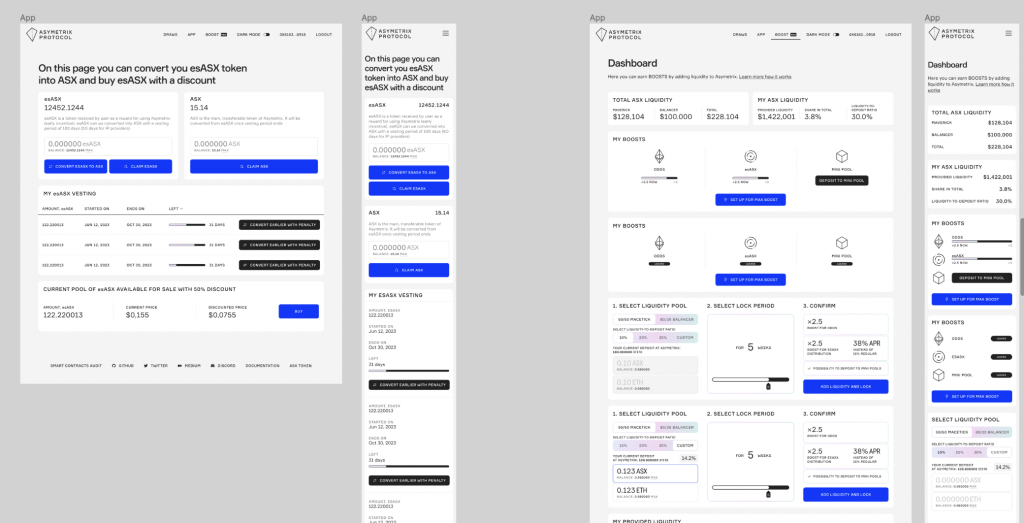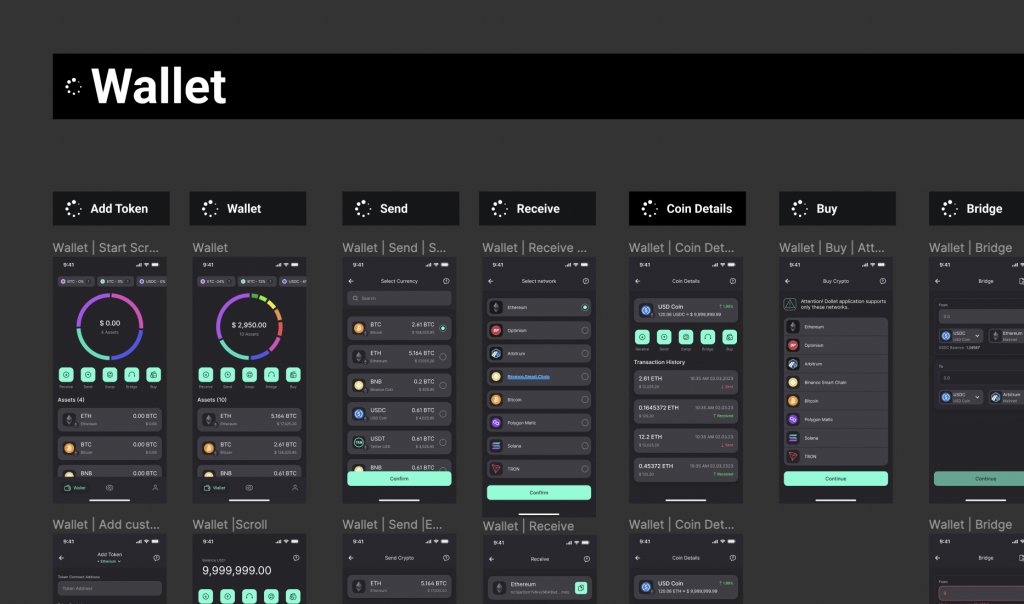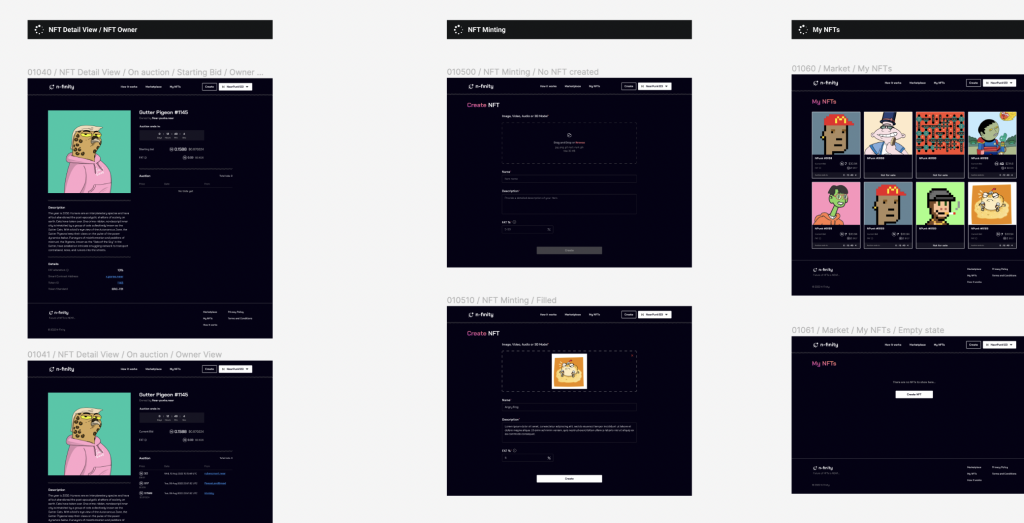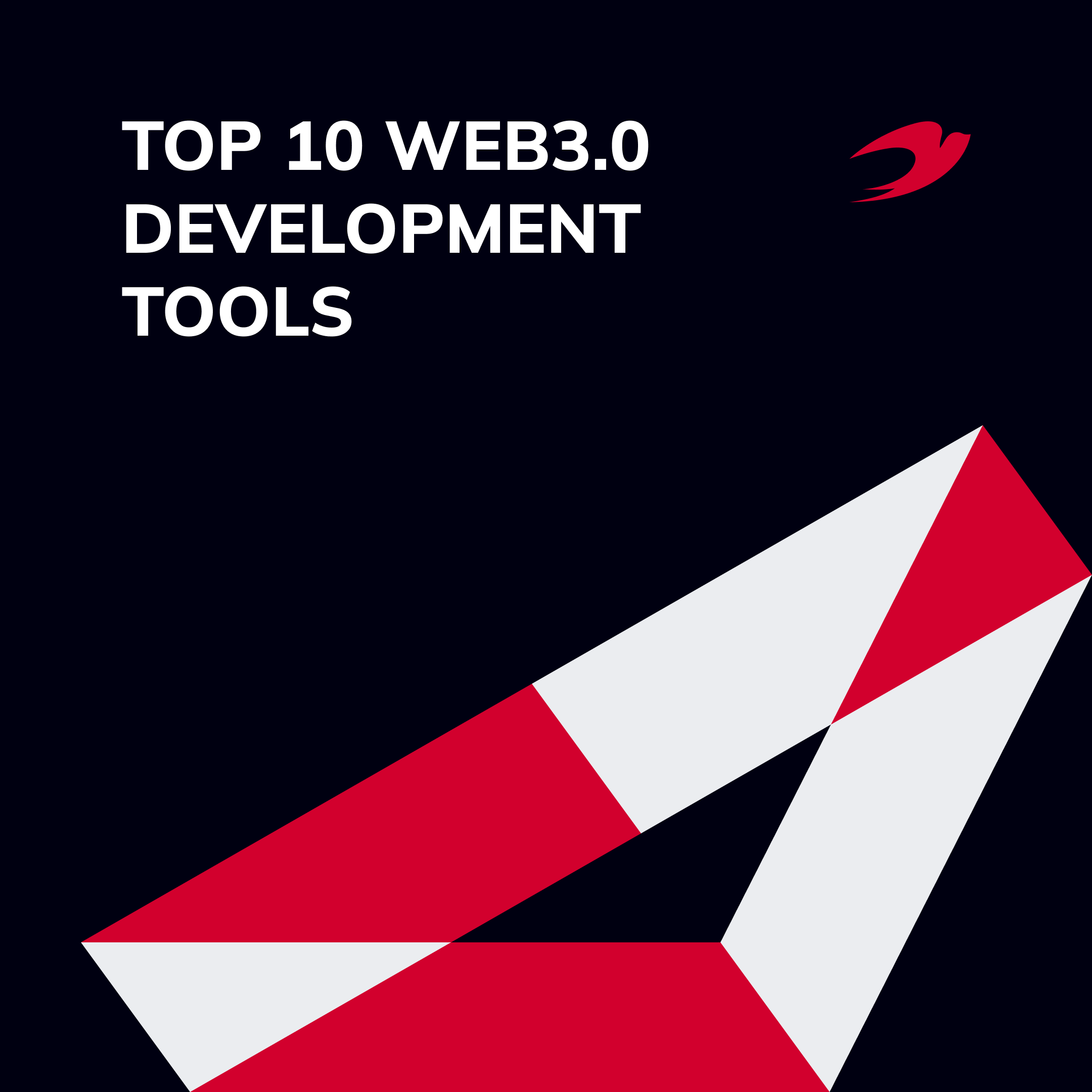We are on the cusp of the Web3 era, marking a fresh phase characterized by decentralization, digital ownership, and the emergence of innovative applications poised to reshape the internet landscape. Web3, also known as the decentralized web, is powered by groundbreaking technologies like blockchain, developing decentralized applications (dApps), and smart contracts. Consequently, developers are eagerly venturing into this dynamic frontier, aiming to leverage its vast potential and pioneer transformative solutions.
The multitude of Web3.0 development tools and platforms makes it challenging to decide which ones are essential for a project’s success. To assist you in navigating this swiftly evolving Web3 landscape, we have compiled an extensive list of the top 10 Web3 dev tools.
How to choose the best tech stack for your project?
With a keen understanding of the intricacies involved, IdeaSoft team meticulously selects the most optimal stack of Web3 tools for startups tailored to specific needs.
Our focus extends beyond immediate requirements to contemplate product scalability, ensuring that the chosen tools align seamlessly with the long-term growth and development of your Web3.0 project. Trust our expertise to eliminate the pitfalls associated with tool selection, providing you with a robust foundation for your startup’s success.
Table of Contents:
- Top 10 Essential Web3.0 Development Tools
- How to Choose The Best Web3.0 Developer Tools for Your Startup
- Web3.0 Development Case Studies
- Summary
Top 10 Essential Web3.0 Development Tools
You probably already know what Web3.0 is. If you don`t, you can read our article about what Web3.0 is. Below are listed the top 10 web3.0 startup development tools you must know.
Tenderly
Tenderly is a top-notch Web 3.0 tool for monitoring, debugging, and analyzing Ethereum smart contracts and decentralized applications (dApps). Tailored to meet the unique needs of developers in the Ethereum ecosystem, this platform offers a comprehensive toolkit. Key features of Tenderly encompass:
- Visual Debugger and Real-Time Monitoring
- Alerting and Notifications to address issues promptly
- Gas Profiler for optimizing smart contract performance
- Simulation and testing capabilities for smart contract development
- Seamless integration with development tools for user convenience
Tenderly aids developers in creating, testing, and optimizing their smart contracts and dApps, ensuring the utmost levels of security, performance, and reliability.
You can also read about building dApp on Solana.
Hardhat
Hardhat stands out as a widely embraced and adaptable development environment tailored for Ethereum, strategically engineered to streamline the generation, testing, and deployment of smart contracts and decentralized applications (dApps). Notable features of Hardhat include:
- Task Runner automates routine tasks
- Hardhat Network presents a local Ethereum network emulator
- Extensible Plugin System enables seamless integration with diverse tools and services through plugins developed by the community
- Solidity compiler integration enhances the efficiency of contract development
- TypeScript support elevates the overall development experience.
This platform caters to Ethereum developers with a potent and expandable infrastructure. It furnishes various features and Web3 startup tools to refine the development workflow and boost productivity.
Foundry
Foundry, crafted by ConsenSys, emerges as a comprehensive smart contract development toolchain. It is proficient in handling dependencies, compiling projects, executing tests, deploying contracts, and facilitating command-line and Solidity script interactions with the blockchain. Key features of Foundry include:
- Simplified blockchain development
- Pre-built integrations
- Customizable templates
- Enterprise-grade security features
- ConsenSys support
The key components of Foundry are Forge (Ethereum testing framework comparable to Truffle and Hardhat), Cast (tool for interacting with EVM smart contracts, managing transactions, and retrieving chain data), and Anvil (local Ethereum node, akin to Ganache or Hardhat Network).
Got lost in tech details?
Let us help you figure it out, and correctly draw up the requirements for your project
The Graph
The Graph stands as a decentralized protocol and indexing service designed for the querying and organization of data sourced from blockchains and decentralized networks. This innovative platform empowers Web3 startup developers to construct robust, scalable, and data-centric applications without relying on centralized servers or proprietary APIs. Key features of The Graph encompass:
- Decentralized querying and indexing
- Composable data indexes (Subgraphs)
- GraphQL API
- Decentralized network for data processing
- Cross-chain compatibility
Through its provision of a standardized, open-source, and decentralized approach to accessing on-chain data, The Graph significantly streamlines the development process, fostering innovation within the blockchain ecosystem.
OpenZeppelin Defender
OpenZeppelin is a comprehensive suite of open-source Web3 security tools, libraries, and frameworks meticulously crafted to aid developers in crafting secure, reliable, and scalable smart contracts and decentralized applications (dApps) across various blockchain platforms, with a primary focus on Ethereum. Key features of OpenZeppelin encompass:
- Reusable and audited smart contract components
- Solidity libraries
- Upgradable contracts
- Security audits
- OpenZeppelin Contracts Wizard
This platform strongly emphasizes offering reusable and audited smart contract components, streamlining development processes, and mitigating potential security vulnerabilities.
Alchemy
Alchemy is a robust and reliable infrastructure provider, offering developers convenient access to Ethereum, Polygon, Optimism, and other blockchain networks. It eliminates the need for setting up and maintaining individual nodes. Key features of Alchemy encompass:
- Multi-chain support
- Feature-rich API
- Easy integration
- Secure environment for interacting with different blockchain networks
- Comprehensive dashboard and analytics
The core objective of Alchemy is to streamline the development and deployment of decentralized applications (dApps) by furnishing a secure, user-friendly API for interacting with diverse blockchain networks.
Orderly Network
Orderly Network represents a fusion of an orderbook-based trading infrastructure and a resilient liquidity layer that encompasses both spot and perpetual futures orderbooks. Diverging from conventional platforms, Orderly Network doesn’t feature a traditional front end; rather, it operates as the backbone of the ecosystem, delivering vital services to projects constructed atop it. Key features of Orderly Network encompass:
- Unified orderbook and liquidity
- Quick & easy development
- Ready-to-use liquidity
- CEX-level performance
- Self-custody
- Collaborative ecosystem
Its DEX white-label solution is meticulously designed to optimize time and capital for developers while providing access to meticulously established liquidity. By the way, IdeaSoft team continously working on Orderly Network back-end technology and infrastructure layers.
Chainlink
Chainlink operates as a decentralized oracle network. It acts as a crucial bridge between smart contracts and real-world data. Key features of Chainlink include:
- Decentralized oracle network
- Data feed aggregation
- Customizable oracle nodes
- External adapter support
- Blockchain agnostic
It facilitates secure and reliable interactions with off-chain data sources, APIs, and diverse resources, significantly enhancing the capabilities of smart contracts.
Moonbeam
Moonbeam stands as a smart contract platform designed to empower developers in building and deploying Ethereum-compatible decentralized applications (dApps) on the Polkadot network. This platform streamlines the development experience by providing a set of Web3 tools, libraries, and APIs that are familiar to Ethereum developers. This way, it facilitates a smooth transition of projects to the Polkadot ecosystem. Key features of Moonbeam encompass:
- Ethereum-compatible smart contract platform on Polkadot
- Familiar tools, libraries, and APIs for Ethereum developers
- Cross-chain communication
- Scalability and on-chain governance
Moonbeam’s overarching goal is to bridge the gap between the Ethereum and Polkadot networks.
Web3.js
Web3.js is proudly one of the best Web 3.0 tools. It is a widely adopted JavaScript library that empowers developers to engage with the Ethereum blockchain and construct decentralized applications (dApps). It functions as an interface to Ethereum’s JSON-RPC API, enabling developers to execute diverse actions. Key features of Web3.js include:
- Seamless interaction with the Ethereum blockchain
- Easy account management
- Event subscriptions feature
- BigNumber support
- Integration with development tools like Truffle and Remix
- Comprehensive documentation
Web3.js is great for querying the blockchain, sending transactions, and working with smart contracts.
How to Choose The Best Web3.0 Developer Tools for Your Startup
Choosing the right Web3 developer tools for a startup is a critical task that requires careful consideration. While navigating the plethora of options available can be challenging, our experienced team, especially during the discovery stage, is adept at streamlining this process for you. With a keen understanding of the intricacies involved, we meticulously select the most optimal stack of Web3 tools for startups tailored to specific needs.
Web3.0 Development Case Studies
At IdeaSoft, we have a lot of diverse experience in developing Web3.0 projects. We know how to design a Web 3.0 app, how to launch a DeFi crypto exchange platform while ensuring AML & KYC compliance in crypto, and much more. Our scope includes NFT, marketplaces, crypto wallets, and over 10 other domains. Here are 3 successful Web3.0 development case studies worth your attention.
Asymetrix
At IdeaSoft, we have successfully implemented the Asymetrix protocol, an innovative decentralized and non-custodial platform. It enables users to stake their stETH with a distinctive method of generating yields.
Using the Asymetrix Protocol, users can participate in the staking process without relying on centralized entities to hold their assets. Instead, they have full control over their funds while benefiting from the unique yield generation mechanism offered by the protocol.

Creating a sophisticated system for distributing prizes, adaptable to platform performance and scalability, involved various challenges. Our team carefully considered factors like user engagement, staking amounts, and platform growth to guarantee equitable rewards. Maintaining a delicate equilibrium between flexibility and precision was vital for ensuring user satisfaction.
Also, crafting a secure platform to safeguard user data introduced further hurdles. It necessitated the implementation of strong encryption, stringent access controls, and routine security audits to thwart potential data breaches, hacking incidents, and other cyber threats. A harmonious blend of user-friendly features and robust security measures is crucial for establishing trust and protecting user information.
Dollet
Our team has experience in non-custodial wallet development. We developed Dollet Wallet – a revolutionary product designed to empower users with effortless management of their holdings across multiple blockchain networks. The project’s core objective was the integration of DeFi strategies into a non-custodial crypto wallet. Our main task was to develop a multi-chain wallet, an admin panel for DeFi strategies management, and customizing smart contracts per specific requirements.

Of course, there were some challenges on this project. Creating an administration dashboard for managing DeFi strategies, integrated with wallet functionality, was a significant undertaking. This involved designing and implementing a panel that facilitates seamless management of various strategies and ensures secure access.
Competing in product user experience (UX) was also a central challenge for the development of Dollet. The goal was not just to match the features of competitors but to consistently surpass them in terms of UX. Given the rapid evolution of the landscape, the wallet must stay abreast of the latest trends while allowing for the effortless integration of new functionalities.
The challenge of establishing a robust legal framework and facilitating the transfer of intellectual property rights was critical. This required meticulous attention to detail in creating contractual agreements that protect the interests of both parties. The legal structure should enable a smooth transition of intellectual property related to the project, ensuring a secure and fair transfer.
N-finity
Another of our Web3.0 development case studies is marketplace N-finity — an online platform with the opportunity to sell and buy non-fungible tokens (NFTs) on NEAR Network. This platform has a unique collateral mechanism called FAT, significantly decreasing trade risks. It’s a type of minimum sale price guarantee that increases with each transaction.

With this Web3.0 project, we had one challenge. The blockchain market, by nature, faces liquidity challenges that demand increased trading activity and motivation for traders. It was difficult for us to implement FAT logic in the N-finity Marketplace. Nevertheless, we successfully solved this challenge and implemented this project in 2 months.
Summary
Web3.0 startup development tools are multiple and ever-changing. Armed with the right tools and knowledge, the experienced development team can construct robust, secure, and user-friendly Web3 projects.
You can always be sure of our expertise and maximum efficiency. We also leverage account abstraction Ethereum capabilities to enhance security and streamline user interactions. When developing Web3 projects, we ensure that the chosen Web3.0 development tools align seamlessly with long-term growth. Feel free to contact us and discuss the details of our future collaboration!

